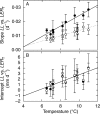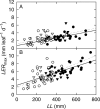A comparative analysis of the temperature response of leaf elongation in Bromus stamineus and Lolium perenne plants in the field: intrinsic and size-mediated effects
- PMID: 17717025
- PMCID: PMC2749633
- DOI: 10.1093/aob/mcm174
A comparative analysis of the temperature response of leaf elongation in Bromus stamineus and Lolium perenne plants in the field: intrinsic and size-mediated effects
Abstract
Background and aims: Growth of grass species in temperate-humid regions is restricted by low temperatures. This study analyses the origin (intrinsic or size-mediated) and mechanisms (activity of individual meristems vs. number of active meristems) of differences between Bromus stamineus and Lolium perenne in the response of leaf elongation to moderately low temperatures.
Methods: Field experiments were conducted at Balcarce, Argentina over 2 years (2003 and 2004) using four cultivars, two of B. stamineus and two of L. perenne. Leaf elongation rate (LER) per tiller and of each growing leaf, number of growing leaves and total leaf length per tiller were measured on 15-20 tillers per cultivar, for 12 (2003) or 10 weeks (2004) during autumn and winter.
Key results: LER was faster in B. stamineus than in L. perenne. In part, this was related to size-mediated effects, as total leaf length per tiller correlated with LER and B. stamineus tillers were 71% larger than L. perenne tillers. However, accounting for size effects revealed intrinsic differences between species in their temperature response. These were based on the number of leaf meristems simultaneously active and not on the (maximum) rate at which individual leaves elongated. Species differences were greater at higher temperatures, being barely notable below 5 degrees C (air temperature).
Conclusions: Bromus stamineus can sustain a higher LER per tiller than L. perenne at air temperatures > 6 degrees C. In the field, this effect would be compounded with time as higher elongation rates lead to greater tiller sizes.
Figures






References
-
- Agnusdei MG, Assuero S G. Leaf tissue flows under grazing and sward structure of different temperate forage grasses in the humid Pampas of Argentina. Proceedings of the II Symposium on “Grassland echophysiology and grazing ecology”; Curitiba, Brasil. 2004. CD-ROM.
-
- Agnusdei MG, Assuero S G, Fernández Grecco RC, Cordero JJ, Burghi VH. Influence of sward condition on leaf tissue turnover in tall fescue and tall wheatgrass swards under continuous grazing. Grass and Forage Science. 2007;62:55–65.
-
- Arredondo JT, Schnyder H. Components of leaf elongation rate and their relationship to specific leaf area in contrasting grasses. New Phytologist. 2003;158:305–314.
-
- Begg JE, Wright MJ. Growth and development from intercalary meristems in Phalaris arundinacea L. Nature. 1962;194:1097–1098.

